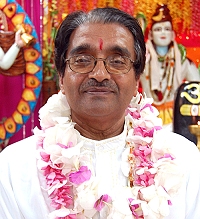From a satsang with Paramacharya of SWAHA, Pt. Hardeo Persad
We offer obeisance to the Shrimad Bhagavad Gita, the Divine Song, an exposition of universal principles to Arjuna by Shri Krishna on the battlefield of Kurukshetra. Devotees should study, practise and live these philosophical principles of the Gita as it provides a solutions to life’s problems. There are 18 chapters, 700 verses in this scripture and the first and last syllables are dhar and ma, respectively. The Gita is the essence of dharma, righteous conduct. Dharma is not only religion, but the constitution by which a person is supposed to live; it is duty, obligations and responsibilities.
From a numerological perspective, the Gita has 18 chapters; 1 + 8 = 9, which is a mystical number. In this world of energy and objects, the number nine plays an instrumental role. There are nine important factors in this world of duality: space, time, causation; creation, sustenance, dissolution; sattvic, rajasic and tamasic prakriti. We are subjected to these nine factors until we free ourselves from the bondage of this world and realise Divinity. The Ganesh Atharva Shirsha refers to the Divine as That Infinite Brahma, He is beyond the Gunas (Gunateerth). He is beyond the three bodies, physical, astral and causal. He is beyond the three states of consciousness: jaagrat (waking), swapna (dreaming) and sushupti (deep sleep); He is turiya (pure consciousness, the highest state). He is beyond time, past, present and future (Kaal teerth). Through the careful study and practise of the Gita, one experiences the great sayings, Mahavaakyas, of the Vedas: Aham Brahmasmi, Tat Twam Asi; the realisation that the Self is the visible manifestation of Thou Art That. The Gita leads us to the realisation of who we are in reality.
We perceive the world through the mind and the senses. We are influenced by the external world because we are controlled by the senses. Arjuna’s chariot, which is steered by Shree Krishna, represents the human body; the horses are the senses; Arjuna is the depressed jiva (individual soul); the reins are the mind and Shree Krishna is the intellect. If the horses pull the chariot in different directions, our senses will be scattered. If we can control the senses, we will have peace and stability of mind.
Arjuna asks Shree Krishna about tranquillity of the mind in the God-realised soul in chapter 2 of the Bhagavad Gita: “Lord, what are the characteristics of a God-realised soul, stable of mind and established in equanimity and tranquillity? How does the person of stable mind speak, sit and walk?”
Bhagavan Shree Krishna replied: “Arjuna, when one thoroughly casts off all cravings of the mind, and is satisfied in the Self through the joy of the Self, he is then called stable of mind. The sage whose mind remains unperturbed amid sorrows, whose thirst for pleasures has altogether disappeared, and who is free from passion, fear and anger, is called stable of mind. He who is unattached to everything, and meeting with good and evil, neither rejoices nor recoils, his mind is stable. When, like a tortoise, that draws in its limbs from all directions, he withdraws all his senses from the sense-objects, his mind becomes steady. Sense-objects turn away from him, who does not enjoy them with his senses; but the taste for them persists. This relish also disappears in the case of the man of stable mind when he realises the Supreme. ”
The Ramaayan also says that all that can be perceived in this world is maya, delusion, as it is transient and impermanent. Shree Krishna is advising that we withdraw and control the senses and concentrate on Him in order to achieve the Divine. He also states that the individual who controls the senses with an unwavering mind, with right focus, loses him or herself in Me, meditates upon Me, becomes absorbed in Me. By concentrating on the Divine, we can rein in the senses from the external world and attain peace and tranquillity of mind.



